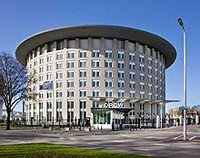17th conference of states parties
The 17th conference of states parties to the Chemical weapons Convention - CWC-

will be held on 26-30 November 2012 in the Hague, the Netherlands.
representatives of the SCWVS as a member of the CWC Coalition are invited to attend the conference and to several side line events organized by NGOs during the conference.
Recent activities and projects of SCWVS include the following
Recent activities and projects of SCWVS include the following:
-
Conducting awareness programs in order to increase public awareness on the consequences of war and the use of chemical weapons (and other weapons of mass destruction)
-
Providing advisory services to the veterans and war victims organization and the government in the fields related to the CW victims
-
Organizing national and international conferences addressing the Medical, environmental and social consequences of the use of chemical weapons
-
Conducting oral history projects based on eye witness accounts of the survivors of CW attacks
-
Increasing awareness in Iran and internationally of the continuing health effects of chemical warfare on both civilians and veterans by preparing educational materials on the topic in Farsi, English, and Japanese.
-
Educating the Iranian and broader international community on important happenings within the framework of the Chemical Weapons Convention.
-
Organizing and establishing the Tehran Peace Museum (2005) as part of an international network of peace museums. Its Mission is to raise awareness of the consequences of war, to promote citizen diplomacy, and to educate the public (especially schoolchildren) on peaceful ways to resolve conflict.
-
Sending delegations of physicians and CW victims to Hiroshima, Japan, each August (from 2004) for the Peace Memorial Ceremony commemorating the 1945 atomic bombing.
-
Hosting annual (since June 2004) delegations from Hiroshima to Iran for Iran’s National Day for Campaigning against Chemical Weapons. In 2007, Japanese visitors toured sites of CW attacks in Iran and attended the opening ceremony of the Tehran Peace Museum and the unveiling of the Peace Memorial in Tehran City Park.
-
Organizing exhibitions on consequences of war and gas attacks:
√ At annual Chemical Weapons Convention conferences at The Hague (since 2003),
√ On the 90th anniversary (2005) of the first attack, at Ypres, Belgium,
√ At the Second Special review Conference of the Chemical Weapons Convention (CWC), The Hague, Netherlands, April , 2008.
√ At several US Universities (including Harvard, George Washington, UCLA) during medical and public events of a US tour in May 2008
Society for Chemical Weapons Victims Support - SCWVS
Society for Chemical Weapons Victims Support - SCWVS
The SCWVS is a Tehran-based non-governmental organization (NGO), founded in 2003 and operates on a national basis, many of its members are survivors of chemical attacks or their family members, it has also many volunteers with different backgrounds.
Long term effects of chemical weapons on health and the environment
Long term effects of chemical
weapons on health and the environment
Society for Chemical Weapons Victims Support
Background
- The Iran–Iraq War (Also known as the longest conventional war of 20th century) began in Sep 1980 when Iraq invaded Iran.
- During the conflict, Iraq began to employ Mustard gas and Nerve agents ( tabun , Sarin and Soman and possibly VX) delivered by bombs dropped from airplanes, artillery and other means; it was the first large scale use of chemical weapons since world war one and a clear violation of international law including 1925 Geneva protocol.
- Chemical weapons employed by Saddam Hussein killed and injured tens of thousands of Iranians, and even Iraqis. Iraq also targeted Iranian civilians with chemical weapons. Many thousands were killed in attacks on populations in villages and towns, as well as front-line hospitals. Many still suffer from the severe effects.
- According to Iraqi documents, assistance in developing chemical weapons was obtained from firms in many countries, including the United States, West Germany, the Netherlands, the United Kingdom, France and China.
- About 1,000,000 Iranian soldiers and civilian were exposed to CW agents and at least 100,000 were hospitalized because of severe injuries; Majority of those who survived developed long term health effects including blood, lung and skin complications.
- Currently over 65,000 of survivors suffer from exposure related illnesses and seek medical treatment regularly, many are still hospitalized with severe, chronic conditions.
-
There are also many thousands of the CW victims who are not registered because of the lack of medical records, many of them are civilians who were injured during gas attacks against residential areas and received medical care in local medical centers or did not have access to any medical center thus no acceptable documents to be recognized by the government to be considered as eligible for receiving medical services.
- In March 2003 the United Nations Monitoring, Verification and Inspection Commission (UNMOVIC) stated that according to Iraqi officials, Iraq dropped almost 19,500 chemical bombs, more than 54,000 chemical artillery shells and 27,000 short-range chemical rockets between 1983 and 1988 on Iranians. Iraq also declared that about 1,800 tonnes of Mustard Gas, 140 tonnes of Tabun and more than 600 tonnes of Sarin had been used during this period against Iran.
history
The first extensive chemical attack by Iraqi troops was carried out in March 1984, when they used tons of sulfur mustard and nerve agents against Iranian soldiers on the Majnoon Islands battlefields (along the northern border). Afterward, extensive employment of chemical weapons by Iraqi troops in March 1985 led to huge Iranian casualties both soldiers and volunteer combatants.
Following many requests by the Iranian Government, three official investigation team were sent to Iran in March 1984, February/March 1986 and April 1987. The conclusions, based on field inspections, clinical examinations of casualties, and laboratory analysis of samples, were released as three official UN reports (S/16433, S/17911, and S/18852). Based on the UN fact finding team's investigations they confirmed the use of mustard gas as well as nerve agents against Iranian troops.












